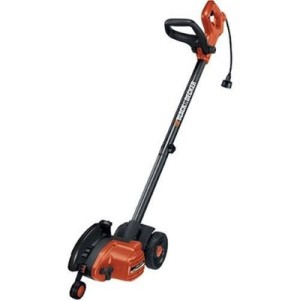How to Bury Radials
So, you have a ground-mounted vertical (or are thinking about it). Good for you! To make it work well, you’ll need radials, and quite a few of them. Sure, some of the manufacturers say you don’t need them, but as others have noted, for the antenna to xmit well (avoiding ground losses), yes, you do need radials.
Depending on your soil, getting the radials installed well — and I mean well enough so they survive the lawnmower — can be a challenge.
Here in north Texas, with hard clay soils, I struggled.
Yes, I tried the “staple them to the ground and the grass will grow over them” method. It had limited success, as some of them popped up enough for Mr. Lawnmower to chew them up. The Bermudagrass here seems to lift them more than bury them. I needed a better (and easier) way.
At the suggestion of NS1L (thanks Jim!),  I decided to dig mini-trenches for the wire to go in. He pointed out a nifty tool called the Black & Decker LE750 Edgehog landscape edger/trencher, available new at Amazon for $90 or reconditioned for $60, also available at WalMart, Lowes, and Home Depot for $90. I decided to bite the bullet, and I’m glad I did. What a neat little machine! In trencher mode, it will dig a narrow trench, perfect for smallish wire, 1 to 1.5 inches deep, quickly, and with little effort, even in clay soils.
I decided to dig mini-trenches for the wire to go in. He pointed out a nifty tool called the Black & Decker LE750 Edgehog landscape edger/trencher, available new at Amazon for $90 or reconditioned for $60, also available at WalMart, Lowes, and Home Depot for $90. I decided to bite the bullet, and I’m glad I did. What a neat little machine! In trencher mode, it will dig a narrow trench, perfect for smallish wire, 1 to 1.5 inches deep, quickly, and with little effort, even in clay soils.
The soil should be moist, if possible — not wet, not overly dry — and a 50′ trench takes about 1 minute. Most of my radials are 45-50′ — remember, buried radials are not tuned radials.
Here is a short video of mine in action. It was set on full depth (1.5″), and the dirt was a hair on the too-dry side, and remember this is hard clay soil.
Then you can add the radial — push it into the trench just a bit, pressing some dirt on top of it every foot or so to help keep it down, then stomp on it a little, and although the narrow trench will be visible for a while, it probably won’t take long for it to disappear.
Hint: decide in advance how many radials you want, plan for where the trenches will be, and do them in order (in a circle). Try to avoid going back and adding more in between existing ones, because it is too easy to hit one of the existing ones, especially if it has already disappeared.
Wow, what a time and back-saver this thing is!
(You can see how I attached the radials to the base of the antenna on my 6BTV page. I have about 25 radials under it, most of them about 50′ long. Sentimental note: my first 40m dipole as Novice in 1978 — the antenna I used for my very 1st QSO — had been taken down years ago, but kept in storage — both halves of it now serve as two of the radials under my 6BTV.)
73, Dave, N0RQ
